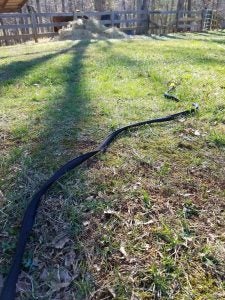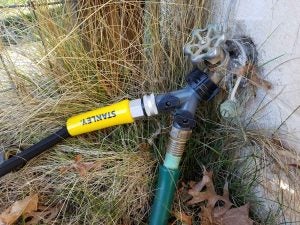I’ll admit: It’s a painful thought to take something brand new and intentionally break it. There are already several damaged and broken items that I keep on my little farm in the hopes of repurposing them later. It makes no sense to want to add to that cache.
Of course, assuming the Stanley hose that Bond Manufacturing sent me to test out was going to work as it should, repairing it would be a breeze. And there would be no need for another damaged item to clog my shed.
The company’s FATMAX Duraflex Expanding Garden Hose was recently launched in the U.S. and Canada — it’s a 25-foot hose that expands up to 50 feet and is made of two-ply construction that’s reinforced with rubber and able to channel a pressure of 300 psi. Though I’ve seen expandable hoses marketed on TV and in hardware stores, I have never used one. To its credit, it did avoid getting kinked up as many standard hoses are prone to do.

I also liked that, because it was made of the flexible, expandable material, all I had to do was pinch the hose near the end to stop the flow of water, without needing to have a nozzle attached to it. This made for quick work moving from the horses’ water bucket to the goats’ buckets and so forth during feeding time.
But the real centerpiece of the product is the quick-repair couplings.
It’s not uncommon to scrape a hose along the edge of a fence or even to get it caught on a sharp piece of machinery. And, if some of that rough-housing leaves the hose damaged, that usually means buying a third-party replacement coupling and hoping that does the trick in fixing it. (For me, sometimes it works, other times, not so much.) Stanley’s hose has everything right there built into the product to reattach the coupling after disposing of the damaged end. The pieces unscrew and can be put back together with ease. It’s simple enough that, if you can’t do it, you probably shouldn’t be a home- or farm owner in the first place.
The video above demonstrates the repair process better than I ever could, but this image below is what the finished repair looked like at my place (I chose to damage and fix the faucet end of the hose to test how it fared closest to the main pressure point).

The only thing I’d suggest is to make sure to grab yourself one of the longer sizes (the lengths available are 25, 50, 75, and 100 feet after expansion). This is rural America, after all, not suburbia, where the majority of us have at least a few acres to play on. Getting extra length out of a hose is important for all those hard-to-reach places.


